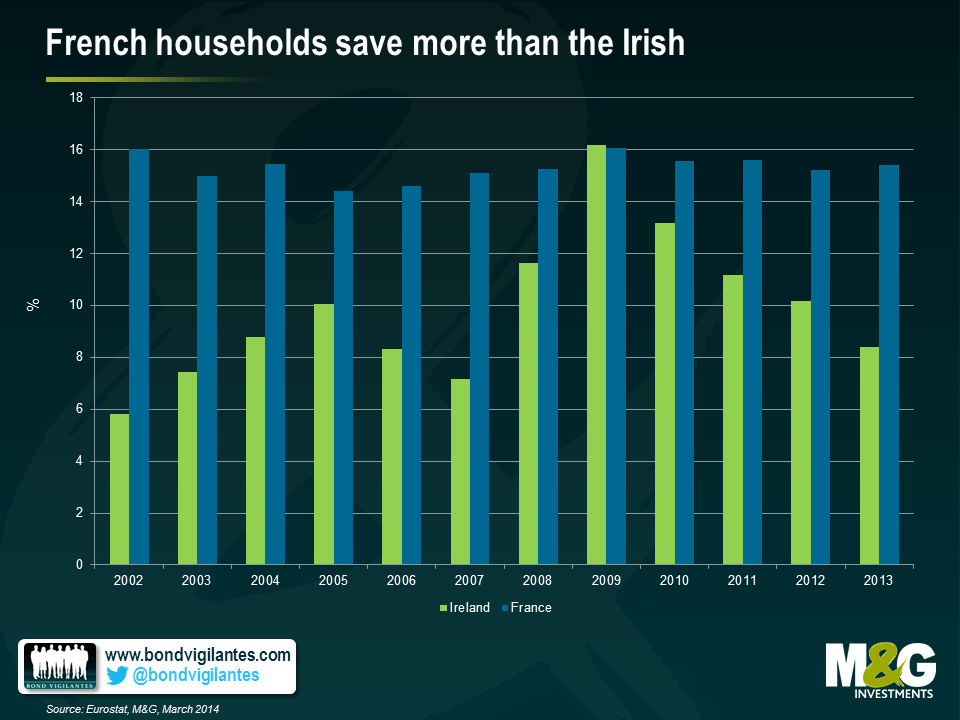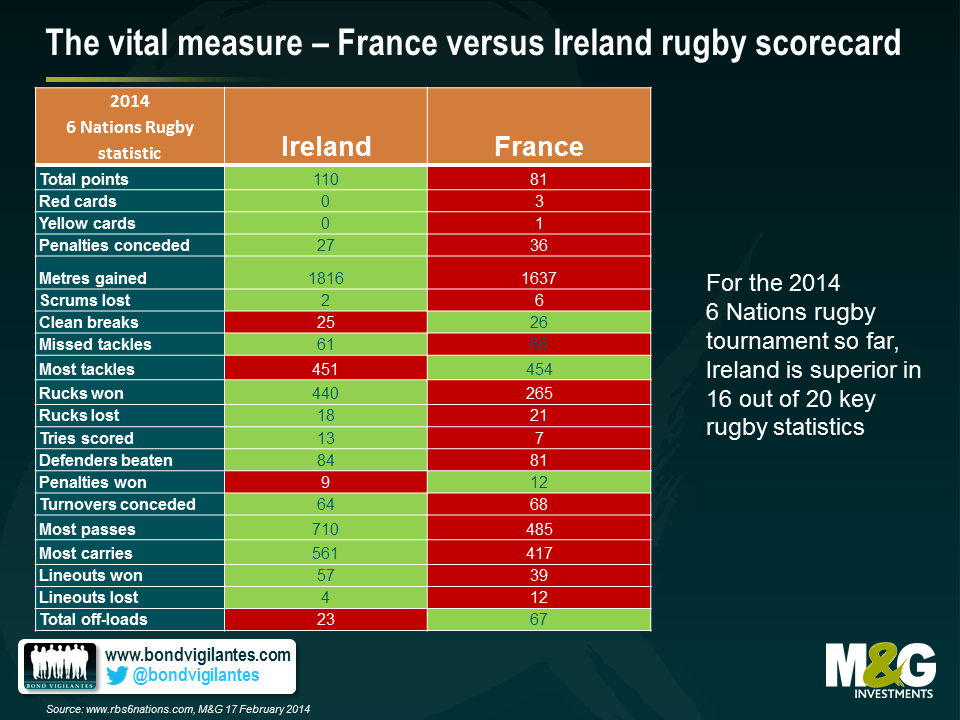France and Ireland – a look at the economic scorecard before the big game this weekend
The 6 Nations Rugby Championship comes to a conclusion this weekend, with three teams still in the running to win. The key game to watch will be France versus Ireland, as a French win would open the door for France or England to win. Of course, England will still have to beat the Azzuri in Rome. An Irish win would see the “boys in green” send record-breaking captain Brian O’Driscoll home to Dublin with the Championship trophy in his final game of rugby.
In the spirit of competition, here is a look at the economic scorecard for France and Ireland. Will it provide an indication of who will win Saturday’s match?
Round 1 – Real gross domestic product per capita
Despite a large deceleration in output from the Irish between the years of 2007-2010, the Irish are still producing around €6,000 more per capita more than the French. IMF forecasts suggest that by 2018, Irish GDP per capita will be around €38,000 while the French equivalent is estimated to be around €30,000. The IMF forecasts suggest that the Irish workforce is expected to remain more efficient and productive than the French in coming years. For the entire Eurozone, the Irish currently rank second behind Luxembourg on this measure. The French are ranked seventh.
On this measure, it is a clear win for Ireland.
Round 2 – The unemployment rate
Based on recent trends, the unemployment rates in France and Ireland appear to be converging. The Irish unemployment rate has fallen from a peak of 15.1% in January 2012 to sit at 11.9% only two years later. Over the same time period, the French unemployment rate has risen from 9.9 to 10.9%. The deterioration in the labour market in France reflects the general stagnation of economic growth. In recent months, the French government has been attempting to tackle the problem of the deteriorating labour market through its active employment policies such as sponsored contracts and training positions for the unemployed.
Despite the improving unemployment rate in Ireland, and worsening unemployment rate in France, round two goes to France on account of the unemployment rate being 1% lower than Ireland. Unless France can generate better growth, it may be the case that in twelve months’ time the Irish unemployment rate is actually lower than the French equivalent. For now, it’s a French win.
Round 3 – Household saving rate
French households have consistently saved between 15-16% of their gross disposable income over the past ten years, suggesting that there is some scope for French consumers to stimulate their economy should confidence pick-up. The Irish household saving rate has been more volatile, falling and rising as one would expect given the concerns around the economic outlook for the country. More recently, Irish households have been spending more and supporting the economic recovery. This is a tough one to call, as the fall in household savings suggests stronger economic growth in Ireland in the short-term. However, because of the potential for French consumer to spend some of their savings in the future, France wins this round.
Round 4 – Percentage of the population with tertiary education
Since 2004 there has been a substantial increase in the percentage of the population that has attained a tertiary level of education in Ireland, with an increase from 24.9 to 35.9%. France, whilst improving, has not been able to generate the same increase and in 2013 the percentage of the population that had obtained a tertiary level of education was 28.7%. Ireland ranks number one while France is at number twelve in the EU on this key measure. There is widespread recognition that tertiary education is a major driver of economic competitiveness in an increasingly knowledge-driven global economy. Ireland’s well educated workforce has certainly assisted the economy in recovering from the financial crisis. It has become increasingly difficult for industries in the west to compete with the emerging nations in terms of manufacturing products; a flexible, highly-educated and competitive labour force is vital in our globalised world.
Ireland’s workforce looks like a winger, whereas the French workforce could be compared to a prop forward. Ireland wins this round.
Looking at measures like real GDP per capita, the unemployment rate, household savings and the level of education in the workforce for Ireland and France is interesting. It shows that Ireland appears very well positioned to generate positive economic growth over the medium term. The old way of categorising European economies as “core” or “peripheral (or worse – PIIGS)” appears no longer relevant, as “peripheral” nations have taken a lot of vital steps to become more competitive through internal devaluation and lower wages. Improved export performance has been reflected in an improvement in current account balances in recent years. Today, the French economy appears cumbersome; it is hampered with a relatively inflexible and rigid labour market and is struggling to become more competitive in a globalised economy as we previously mentioned here.
Final round – the rugby statistics
After a 2-2 economic scorecard, the final round had to focus on the rugby itself. Unfortunately for the French, the Irish rugby team appear superior in 16 out of 20 key rugby statistics including total points, metres gained and lineouts won. The French have home advantage which is a big positive; though this will be mitigated by the emotion felt by the Irish players given it is Brian O’Driscoll’s last match.
This leaves a 3-2 economic and rugby scorecard win to Ireland over France. That said, it would take a brave pundit to discount Les Bleus, who have a habit of rising for the big occasions. If you don’t believe me, just ask any New Zealander.
The value of investments will fluctuate, which will cause prices to fall as well as rise and you may not get back the original amount you invested. Past performance is not a guide to future performance.


18 years of comment
Discover historical blogs from our extensive archive with our Blast from the past feature. View the most popular blogs posted this month - 5, 10 or 15 years ago!


Bond Vigilantes
Get Bond Vigilantes updates straight to your inbox










